Highbrow meets lowbrow
Premium and more basic brands forming partnerships is a growing trend, appealing to consumers who want to get the best of both the high and low-end, and brands that are aiming to expand their reach
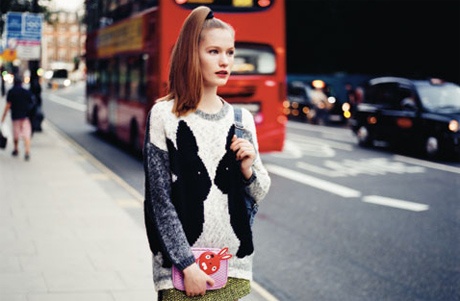
Mix it up: Topshop and Nordstrom
The combinations of hotdogs with champagne, football and fine wine and Topshop and premium US store Nordstrom might seem unusual - but in an austere economic environment, a new strategy has emerged: that of mixing the high-end and the everyday to reach a wider audience.
The likes of Aldi, for example, is doing well in tough times, using the line ‘like brands only cheaper,’ in its marketing. Joint managing director Roman Heini says it is attracting more A and B demographic customers and in Germany it is making the most of this by partnering with more upmarket store Rewe and trading under the same roof.
Meanwhile, high street retailer Topshop announced its partnership with the premium but conservative US department store Nordstrom, something which Forbes magazine calls a ‘retail odd couple’, but which stands to increase Topshop’s presence in the States while upping Nordstrom’s fashion credentials.
Best of both
James Wallman, editor at LS:N Global - the trends network of The Future Laboratory, who calls the new movement ‘lo-hi,’ says that it is becoming fashionable to mix up premium brands and more basic ones. The target audience, price and brand values are entirely different, but low-end and high-end brands are collaborating to appeal to people who want the best of both.
“The reason brands are doing it is to appeal to today’s consumer. We are now lo-hi shoppers. These days, people are much more prepared to mix and match. In the past, you would consider yourself a high street or luxury shopper and you wouldn’t mix the two. But that’s now become something that people do, they mix and match not just the brands they buy, but the level and type of brand they buy,” Wallman says.
This strategy has helped Chilean wine brand Concha y Toro reach sales of nearly $900m (£560m) last year. It has been a sponsor of Manchester United FC for three years - but only outside the UK. While British football fans might be more used to links with mass-market beer brands such as Carling, the more refined taste of wine allows Concha y Toro to find ‘opportunities in new markets,’ according to international marketing manager Sebastian Aguirre.
Partnerships
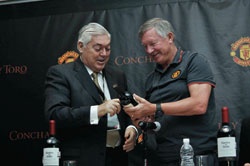
Concha y Toro wine and Man Utd
The football club contacted the wine brand when it realised it had something in common: a red devil features on Concha y Toro’s Casillero del Diablo wine bottle, while United’s players are known as the red devils.
The company does little by way of promoting the partnership in the UK, other than at Old Trafford, Manchester United’s ground. The opportunity was in the powerful global brand the club has built up, something that Concha y Toro wanted to tap into.
“Through the partnership with Manchester United, we saw an opportunity to further strengthen Concha y Toro’s global presence, a key goal for us over the past few years,” Aguirre says.
“As one of the world’s most popular and successful football teams worldwide, with a strong presence in many of our target, developing markets such as Asia, Latin America, Africa and Eastern Europe, Manchester United provides opportunities for us to enhance the visibility of the Concha y Toro brand to a new audience.”
Manchester United also had an agenda to reach different audiences. The club was looking for a strong Latin American brand to strengthen its presence in the region, this being the wine brand’s natural market, owning the largest winery in the region.
The company is also keen to ‘offer quality to different audiences’. Aguirre says: “Wine consumption is increasing worldwide, new markets are showing interesting opportunities for wine exports and that trend is also present within sports marketing. Wine is associated with good gastronomy and premium experiences and you also have these kind of situations associated with first-class football.” It can also reach VIP guests, providing more upmarket wine to corporate lounges at Old Trafford.
Premium experiences
Making premium experiences more accessible is also a feature in dining, where the trend is seeing pop-ups and new restaurants offering the best of both (see lo-hi dining, below).
London restaurant Bubbledogs, which opened in August, offers diners a choice of champagne, served alongside hot dogs. A review from Time Out magazine states: “Bubbledogs teams four-star drinking with two-star dining.” They may seem unlikely bedfellows, but the combination is working, according to restaurant manager Sandia Chang.
“It goes down really well. It’s a chance for me to introduce customers to some of my favourite small champagne producers in a relaxed setting, with really fun food - hot dogs, tater tots [potato croquettes] and fries. The key idea is that we are making something that’s often seen as ‘fancy’ or out of reach - champagne - accessible by pairing it with unpretentious food - hot dogs. But more than that, hot dogs, with their salty, meaty flavour, work well with the refreshing, clean flavours of champagne.”
Chang believes the concept works because the economy means people have a bit less to spend. “When they do spend, they want to spend on the really core elements of eating out: great food and great wine. That’s at the heart of what we do, the rest of the ‘trimmings’ are extraneous.”
The Seagrass, a high-end pop-up restaurant based in London’s Chapel Market, operates in the evenings from a restaurant that is a more mainstream pie and mash shop called Manze’s during the day. This combination offers diners a premium menu in humble surroundings.
The business works in collaboration with the restaurant, opening four nights a week, but Iain Sim, head chef and partner at The Seagrass, says he’s surprised by the number of people - at least five per cent of its customers - who have eaten both at the restaurant and the pie and mash shop.
“It’s quite funny because they are eating lobster and venison in the evenings and they still love coming for pie and mash, even though it’s the complete opposite end of the spectrum,” says Sim.
Using a shared venue cuts cost for The Seagrass, but it also opens up both restaurants to new customer potential. “People are very surprised,” says Sim. “Especially those who live in that area and have never wanted to go in there for pie and mash. People love the building; it’s 150 years old and has a great atmosphere. It’s something different and I would say the venue adds as much as the food does to the whole experience.”
Failed experiment
Mixing high-end and low-end doesn’t always work, as motorway diner Little Chef knows. Its partnership with Heston Blumenthal involved an overhaul of its menu, offering ox cheek and Scottish mussels, [as well as more traditional scampi and chip-type dishes]. Yet many of the dishes created for the chain by the Michelin-starred chef were taken off the menu as they didn’t sell and the brand is now reverting back to basics (see case study, page 18).
Other brands have looked to more obvious partnerships to reach new audiences. EBay, which has been repositioning itself as a shopping destination rather than solely an auction site, partnered with the British Fashion Council’s Fashion Forward initiative in July this year to promote new and emerging designers. This saw eBay open its first pop-up online designer shop in the UK with Henry Holland, a Fashion Forward designer, to coincide with London Fashion Week.
The partnership allows eBay a greater presence in the fashion world while the British Fashion Council gets to promote its work with new and emerging designers in the UK on a wider consumer platform which eBay provides.
Increased visibility
Melanie Smallwood, head of eBay fashion brands, says: “EBay’s partnership with the British Fashion Council helps us increase our visibility in the fashion sector with consumers and other retailers, while building on our brand reputation as a credible fashion destination.”
Smallwood adds: “Our involvement with Fashion Forward allows us to support young designers, through direct sponsorship, but also by enabling them to sell through our platform and gain access to the 17 million people who visit our site every month.
“That’s a huge audience for any brand, but particularly a fledging designer. The benefit for us is that we get to add more designers and products to the selection of fashion items available on our site.”
Mutual benefit
The premium/everyday trend enables brands to reach a wider audience, but these collaborations are not just about this, Smallwood claims.
“A successful partnership is one that benefits both parties and the most effective collaborations are those that build on the strengths of each brand to deliver a new and enhanced offering or product.”
This description could also be applied to the collaboration between luxury leather goods brand Ettinger and tattoo artist Saira Hunjan, known for inking the bodies of celebrities such as Kate Moss and Jude Law. The British brand, which has been creating products since 1934 and is a member of Walpole, the luxury organisation, was approached and agreed to the collaboration as it wanted to create a product that was a bit edgier without alienating its existing customers (see Q&A, below).
Chief executive officer Robert Ettinger says: “Yes it is a tattoo and you think of that as different from ‘normal’ Ettinger, but the designs are based on traditional British things such as foxes and pheasants. So we haven’t gone off on a complete tangent. We are still quite within the realms of our customers but we have also done something that’s seen as acceptable by some of the edgier retailers as well.”
An ongoing trend
Wallman at LS:N Global says the hi-lo trend will carry on over the next ten years. “It’s something that people are expecting more and more. Consumers want to mix and match and create their own thing, and we will see that happening in this decade.
“Brands will do the same as well, as a way to survive and thrive and appeal to more people. We are seeing the early stages of this. Wouldn’t it be interesting to see Waitrose and Lidl opening up a store together in the UK for example?”
So mixing champagne and hotdogs or football and fine wine needn’t leave a bad taste in a marketer’s mouth: in fact these collaborations could help to make life in the age of austerity a little sweeter.
Lo-hi dining
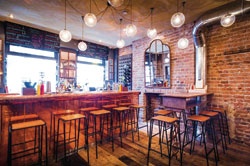
Bubbledogs
Bubbledogs
The restaurant opened in August this year and serves only champagne with the more down-to-earth hotdogs. Restaurant manager Sandia Chang says the idea behind Bubbledogs was to make something that’s often seen as fancy or out of reach, accessible. Both this restaurant and The Seagrass use social media to market their ventures.
The Seagrass
This pop-up restaurant is serving up fresh British produce in the 19th century Manze’s pie and mash house in Chapel Market, London. Four nights a week, diners can experience gourmet food in humble surroundings and are offered three courses for £30 with bring-your-own booze. Chef Iain Sim says there have only been a few occasions when a diner has come in during the evening in search of pie and mash.
Pizza East, Chicken Shop and Dirty Burger
All owned by the Soho House Group, these restaurants combine a premium ambience with the feel of fast food. On the ground floor is London’s third Pizza East serving gourmet pizza in a rustic environment, while downstairs is Chicken Shop, where free-range birds from Banham’s Farm in Norfolk are marinated overnight, steamed and then cooked over charcoal on a special rotisserie. Out the back in a corrugated iron shed is Dirty Burger, serving burgers from a counter.
Q&A: Robert Ettinger
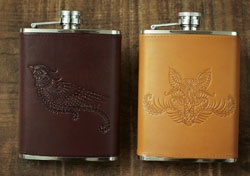
Ettinger
Chief executive officer of luxury leather goods maker Ettinger, which worked with tattoo artist Saira Hunjan to create a collection of products.
Marketing Week (MW): What was the thinking behind the collaboration with tattoo artist Saira Hunjan?
Robert Ettinger (RE): We like to work and partner with like-minded companies that produce the best products in their field. It’s about a meeting of minds, where everybody works together. We felt that Saira Hunjan is the very best in what she does, she’s not just a tattoo artist, she’s an artist. She also works on all the top people like Jude Law and Kate Moss, so she is highly regarded in her field.
MW: Do you think a collaboration with a tattoo artist would be surprising for customers who are aware of your heritage?
RE: We did quite a lot of research into tattoos - they probably have a bad name, but in the 1900s a lot of the aristocracy had tattoos and even Queen Victoria had one round her wrist.
Yes it is tattoo, and you think of that as different from normal Ettinger, but the designs are based on traditional British things.
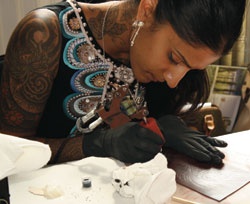
Saira Hunjan
MW: Were you aiming for a different audience?
RE: Not necessarily. We have had some PR in The Field and Country Life magazines and that is what I call the hunting, shooting and fishing British. We have had a lot of response from their readers who love the designs. We are still quite within the realms of our customers, but we have also done something that’s seen as acceptable by some of the edgier retailers as well.
MW: Ettinger’s and Hunjan’s target audience are both quite different. How does each party benefit from the collaboration?
RE: Some of our newer collections are selling to much younger people, rather than the hunting, shooting and fishing type mentioned before. We are benefiting because we have never worked with an artist before and she has never worked with a commercial manufacturer of a product. We benefit from being recognised for doing something a little bit different and working with someone who is known in the field. We felt that working with a designer who is a little edgier would allow us to open up some new distribution opportunities in different sorts of top-end retailers.
MW: Why do you think the collaboration works?
RE: More and more people are looking for products that are a bit different. You can’t reinvent the wheel when you are making a purse or wallet; it’s still got to hold your money and credit card, so it has to be that shape. But what you can do is change the colour and design. Putting this design on the outside of the product makes it into a piece of art rather than a wallet. It changes the whole concept of an accessory.
With all our collaborations there has been a meeting of minds. Saira understood our craftsmanship and our British heritage and we had shared values, it’s all about working with somebody who understands Ettinger. We are not trying to change direction, we are trying to do something that is different and special.
Case Study: Big Chef takes on Little Chef
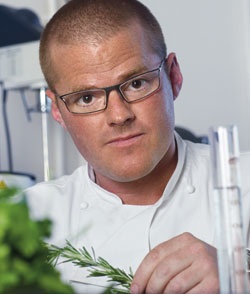
The trend towards mixing posh with basic also translates into dining and can be seen in Little Chef’s attempt at changing consumers’ opinion of its restaurants.
In 2008, Little Chef’s 50th anniversary, the brand announced that celebrity chef Heston Blumenthal would be overhauling the menu and interiors, which was publicised through a Channel 4 documentary, Big Chef takes on Little Chef.
The company had been saved from collapse by a private equity company in 2007 as profits dropped over several years. However, bringing in the celebrity chef, whose own restaurant has been awarded three Michelin stars, didn’t fully appeal to consumers.
With Heston on board, the roadside restaurant served Scottish mussels in white wine sauce and braised ox cheeks, and saw an overhaul of its most popular dish, the Olympic breakfast, with 50 per cent more meat and introducing sausages made with outdoor-reared pork.
The chef also made his mark by offering diners a chip shop aroma spray for those ordering fish and chips. In this case the collaboration concept wasn’t as successful as the company hoped.
Graham Sims, chairman of Little Chef, says: “Heston brought us some fabulous ideas in terms of provenance and procurement. It was a little wild when it came to translating that into menu dishes. There are a few dishes that we still have from that time but some of the fancier ones just didn’t sell, so we took them off.”
The trend enables mass-market and high-end brands to spread their products to new audiences and it was Little Chef’s audience that contributed to the company reverting back to basics. The brand has since added a new menu, partnering with brands, such as Cadbury, Lavazza and Yorkshire Tea, and one month ago launches a takeaway brand called Little Chef Express.
Sims adds: “We’ve moved on now to go back to basics, which is what our customers said they wanted. Little Chef is an iconic brand and one that everyone recognises even if they haven’t been there for 10 years. In many respects that’s been the problem - people remember it from the past but they haven’t come back because it had gone through a number of iterations as private equity houses bought it and sold it.
“So for the past six or seven months we’ve been going back to basics, and we make no apologies for that. We talked to 9,000 of our customers and got many great insights about what the British public needed from us.
That has laid down a very strong platform for us now.”
Sims mentions that this new platform is about going back to Little Chef’s heritage. “Our menu now is what people remember a Little Chef menu looking like 15 to 20 years ago. In the interim, we went off on various journeys to create fancy restaurants and fancy menus, none of which worked. What we have now is what our customers say they want and so we’ve brought it back. That’s the platform against which we’re growing now.”









